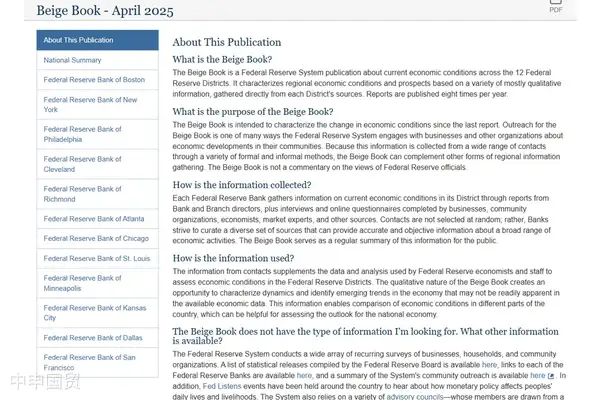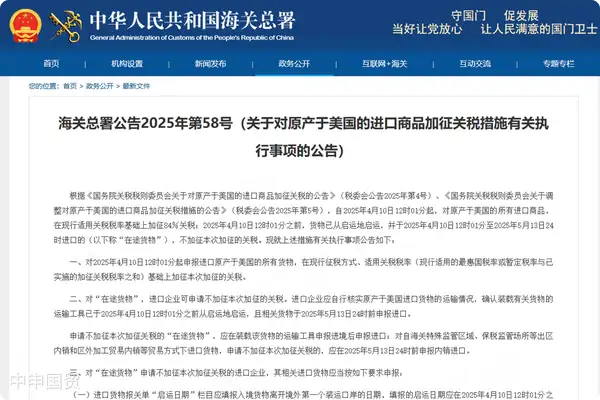- Shanghai Zhongshen International Trade Co., Ltd. - Two decades of trade agency expertise.
- Service Hotline: 139 1787 2118

I. Abstract
The Federal Reserves Beige Book is an important report reflecting the current economic conditions of the twelve Federal Reserve Districts in the United States, providing valuable qualitative insights into economic sentiment. The latest version of the Beige Book released on 2025年4月23shows that the term tariffs appeared 107 times. If related trade terms are added, the total reaches 123 times. This highlights the widespread concern of the business community about this issue. The analysis shows that the core problems caused by tariffs include increased economic uncertainty, rising corporate input costs, the transmission of costs to consumer prices, and significant impacts on business investment and overall economic activity. The manufacturing, retail, agriculture, construction, and automotive industries are particularly sensitive to tariffs. The extensive discussion of tariffs in the Beige Book indicates that its significant impact on the current economic environment has been generally perceived by businesses and key contacts of the Federal Reserve.II. Introduction: The Beige Book and the Focus on Tariffs
The Federal Reserve releases the Beige Book eight times a year, summarizing the economic condition reviews of each Federal Reserve District. The report is based on the reports of banks and branch directors, as well as interviews and online surveys with businesses, community organizations, economists, and market experts, providing qualitative information on regional economic conditions and prospects. These qualitative data complement the quantitative analysis used by Federal Reserve economists and staff to assess economic conditions and guide the decision - making of the Federal Open Market Committee (FOMC). Given the importance of current international trade policies and tariffs, this article analyzes the frequency of the term tariffs and its impact in the latest Beige Book released on 2025年4月23. The prevalence of tariff discussions reflects its potential role in various aspects such as corporate costs, pricing strategies, consumer behavior, and overall economic growth.
The Beige Book provides a unique perspective by capturing the real - time sentiment and experiences of businesses and contacts across the country. Compared with official economic statistics that reflect historical performance, the Beige Book can more timely reveal how current events and policies (such as the implementation or anticipation of tariffs) affect economic behavior and expectations. This near - real - time business insight makes the Beige Book an important tool for understanding changes in the economic landscape and the potential impact of trade policies.
III. Mention Frequency: The Significance of Tariffs
In the latest Beige Book released on 2025年4月23, the term tariffs and its related terms (such as tariff - related) appeared more than 70 times. This frequency highlights the importance of tariffs in the current economic discussion, reflecting the general concern of businesses and contacts in the twelve Federal Reserve Districts about tariffs. Whether in the national summary or the reports of each district, the repeated appearance of this term indicates that the impact of tariffs is being perceived and discussed by a wide range of industries and regions. The high frequency of mentions further emphasizes the prevalence of tariff - related concerns in the economic environment perceived by the Federal Reserves extensive contact network.
IV. Thematic Analysis: An Analysis of the Impact of Tariffs
A. Increased Economic Uncertainty
A prominent theme in the Beige Book is that tariffs have significantly increased the current economic uncertainty. The national summary clearly states that uncertainty in international trade policies is widespread in the reports, and the economic prospects of many districts have significantly deteriorated due to tariff - related uncertainty. For example, the Second District (New York) reported that increased uncertainty is putting pressure on businesses and consumers, and many businesses expressed serious concerns about the potential negative impacts of tariffs. The Boston District pointed out that concerns about the impact of tariffs have increased, mainly affecting the prospects, leading contacts to be more pessimistic about the economic outlook. This uncertainty not only stems from the cost increase directly caused by tariffs but also from the uncertainty of future trade policies and possible retaliatory measures by other countries. Businesses find it difficult to formulate long - term strategies and investment decisions when trade rules may change. Many districts reported that businesses are taking a wait - and - see attitude towards recruitment until the economic situation (especially related to tariffs) becomes clearer. This hesitation caused by the unpredictability of tariff policies may ultimately drag down overall economic growth.
B. Rising Input Costs and Price Pressures
B. Increase in Input Costs and Price Pressure
The Beige Book extensively documents the impact of tariffs on the increase in input costs for enterprises in various industries. The national summary states that most districts noted that businesses expected tariffs to accelerate the growth of input costs. Many enterprises have received notices from suppliers regarding cost increases. The reports from various districts further confirm this. For example, in the New York district, the price increases of wholesale and construction materials such as steel, aluminum, and imported doors are partly attributed to tariffs. Manufacturers and construction contacts in the Cleveland district reported that the costs of materials such as steel have increased due to tariffs. The Minneapolis district mentioned that the prices of raw materials in the manufacturing and construction industries are expected to rise due to tariffs, especially for steel and aluminum. In response to the increase in costs, enterprises have adopted various strategies, including adding tariff fees to prices or shortening the pricing cycle to adapt to the uncertainty of trade policies. Most enterprises expect to pass on these additional costs to consumers. However, the Beige Book also points out that in industries with weak demand (especially in the consumer - oriented sectors), the profit margins of enterprises are under pressure, limiting their ability to fully pass on costs. This indicates that the inflationary pressure caused by tariffs is complex, potentially driving up consumer prices while squeezing the profits of some enterprises.
C. Impact on Business Activities and Investment Decisions
The Beige Book emphasizes the significant impact of tariffs on business activities and investment decisions. The uncertainty and cost increase related to tariffs have led some enterprises to postpone or reconsider their investment plans. For example, commercial real - estate contacts in the Philadelphia district pointed out that early development projects were suspended due to changes in tariff costs. The Richmond district reported that investments were put on hold due to increased tariff uncertainty. Some contacts in the St. Louis district said that they were reluctant to implement or formulate capital investment plans due to the continued tariff - related uncertainty^. In addition, tariffs have also suppressed the demand in some industries. The New York district expects tariffs to reduce activities, and the Cleveland district reported that the demand for manufactured goods remained weak due to continued tariff uncertainty. However, some industries experienced a temporary increase in activities as consumers rushed to buy before the price increase due to tariffs. For example, the national summary mentioned that the sales of automobiles and non - durable goods increased, attributed to tariff expectations. Automobile dealers in the Philadelphia and Cleveland districts also reported increased sales due to consumer rush purchases. This shows that tariffs may distort demand in the short term, but demand may slow down after price adjustments.
D. Impact of Tariffs on Specific Industries
The Beige Book provides detailed examples of how tariffs affect specific industries. In the manufacturing industry, districts such as New York, Cleveland, Richmond, Atlanta, Chicago, and Minneapolis generally expressed concerns about the increase in input costs such as steel and aluminum. Manufacturers in the Cleveland and Richmond districts were also worried about retaliatory tariffs on exports. The retail industry faced challenges due to the increase in import costs, as reported by multiple districts including Boston, New York, and Cleveland. Retailers were concerned about the impact of cost - passing on demand and the uncertainty of their future pricing. The agricultural sector was concerned about the increase in the costs of imported inputs such as fertilizers (in the Atlanta and Chicago districts) and the loss of export markets (in the Chicago, St. Louis, etc. districts). The construction industry experienced project delays or cancellations due to the increase in the costs of materials such as steel and wood, and this also raised concerns about housing affordability (in the Boston, New York, etc. districts). The automotive industry experienced an increase in sales due to consumer rush purchases (as mentioned in the national summary and in districts such as New York and Philadelphia), but the long - term impact on prices and demand was a cause for concern.
E. Regional Differences in Tariff Concerns
Although tariff concerns are widespread in all Federal Reserve districts, their manifestations and intensities vary depending on the regional economic structure and trade links. For example, the New York district emphasized widespread concerns about supply reduction, increase in input prices, and hindrance to investment. The Kansas City district was concerned about the agricultural sector and the risk of reduced exports. Enterprises in the Dallas district generally worried about the impact on demand and costs, and some enterprises were unable to pass on costs. The Richmond district reported a sharp drop in equipment sales and an increase in raw material prices after the steel and aluminum tariffs. These differences highlight the different impacts of tariffs on economic activities in various regions.
V. Conclusion: Tariffs as a Major Drag on the Economic Environment
An analysis of the latest Beige Book shows that tariff concerns are widespread and significant in the US economy. Its frequent mention highlights the central role of tariffs in exacerbating uncertainty, driving up enterprise costs, and potentially leading to an increase in consumer prices. Enterprises are actively responding to the impact of tariffs by adjusting pricing strategies or postponing investments. The manufacturing, retail, agricultural, construction, and automotive industries face unique challenges, and regional differences reflect the economic diversity of each Federal Reserve district. The universality of these concerns indicates that trade policies, especially tariffs, are important factors shaping the recent economic outlook, potentially acting as a drag on economic growth and exacerbating inflationary pressure. The Beige Book, by documenting the on - the - ground experiences of enterprises, has become a valuable tool for understanding the real - time impact of tariffs.
VI. Appendix: Mentions of Tariffs in Each District
| Federal Reserve District | Number of Mentions (approx.) |
|---|---|
| National Summary | 4 |
| Boston | 6 |
| New York | 11 |
| Philadelphia | 5 |
| Cleveland | 12 |
| Richmond | 13 |
| Atlanta | 8 |
| Chicago | 10 |
| St. Louis | 14 |
| Minneapolis | 11 |
| Kansas City | 9 |
| Dallas | 13 |
| San Francisco | 7 |
| Total | 123 |
Note:This table reflects the number of occurrences of tariffs and its related terms in the reports of each district. The total is more than 70 times, providing a more detailed district - level analysis.
Related Reading: The Fed Beige Book The Fed – Beige Book – April 23, 2025
Related Recommendations
? 2025. All Rights Reserved. Shanghai ICP No. 2023007705-2  PSB Record: Shanghai No.31011502009912
PSB Record: Shanghai No.31011502009912










